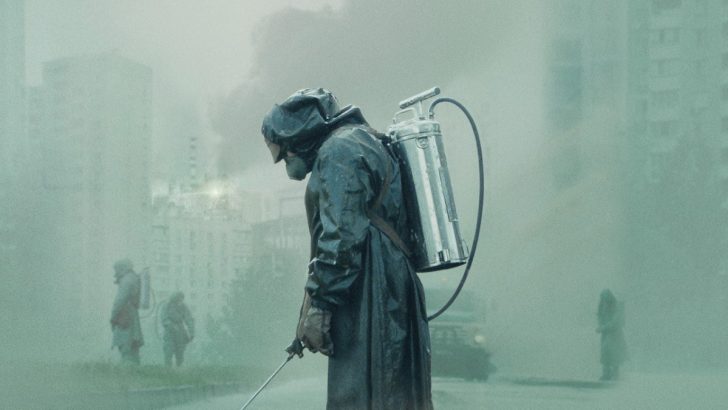Really, I was only ever superficially aware of the disaster of Chernobyl. Yes, I remember when it happened in April 1986, and that it was awful, and indicative that the Soviet Union was hopelessly badly organised – something I had seen in visits to Russia and the USSR anyway.
And I admired the work that Adi Roche had done for the children of Chernobyl, and the way in which her charitable gesture had touched so many Irish hearts.
But my awareness was quite shallow until, over the Christmas and New Year break, the boring mainstream TV fare drove me to watch a DVD set that I had acquired, almost as backup entertainment, during 2019. This was the drama Chernobyl, starring Jared Harris, Emily Watson and Stellan Skarsgard. There are two discs and five episodes, and once I started viewing, I was utterly gripped. Small wonder it was covered in awards after it was launched in May last year.
Background
There is no sex, no romantic angle, no acts of human violence and even the characters portrayed aren’t given much of a contextual back story. Jared Harris (son of Limerick actor Richard Harris and his wife Elizabeth Mostyn-Owen), who plays the scientist trying to uncover the truth, Valery Legasov, reveals almost nothing about the character’s background – we don’t know whether he has children, siblings or even friends.
Similarly with Stellan Skarsgard’s Boris Shecherbina, the Soviet big cheese who initially claims the nuclear explosion can be managed, and kept secret, by Soviet power.
Emily Watson’s character is a semi-fictional composite, but even there you expect perhaps a romance to develop between this attractive nuclear physicist and either Harris or Skarsgard: but the relationships are austere and focused on their mission.
It is also a heroic story: the picture of a man, Legasov, who was willing to put his career on the line to seek out the truth”
So Chernobyl has none of the usual ingredients which are traditionally supposed to feature in a great movie. It is just a compellingly important story, told by the director and writer Craig Mazin, with undimmed commitment. It illuminates the terrible disaster that Chernobyl was, and what untrammelled powers we are dealing with in matters like nuclear energy.
But it is also a heroic story: the picture of a man, Legasov, who was willing to put his career on the line – and that meant becoming an unperson in the USSR – to seek out the truth. It is also a story of the heroism, not of the big cheeses in power, but of the ordinary men and women who acted so bravely to try and halt the disaster – especially the coalminers, who willingly risked their lives to get into the core of the reactor and clear the poisonous graphite.
Radiation
I said there was no romantic storyline, but there was a love episode involving Lyudmilla Ignatenko, who somehow wangled her way into the hospital where her husband, Vasily, was dying in the most appalling agony from radiation sickness.
Forbidden to touch him, she nevertheless kissed and embraced him and tended to his suppurating wounds, and comforting him with the news of her pregnancy. She suffered as a consequence, but she came through, and lived to be a mother, defying medical predictions.
Definitely the best screen experience of 2019 for me. And now I understand Chernobyl.
***
We should celebrate Nollaig na mBan, but isn’t it really more about the Feast of the Epiphany?
It seems that January 6 is now more feted as Nollaig na mBan than as the Feast of the Epiphany, or as it’s often called, the Feast of the Three Kings.
I have nothing against the ‘Women’s Christmas’, which was observed in Irish tradition going back centuries. In the devotional literature of the 1930s and 40s, menfolk were urged to spare the women of the house all those household chores on that day, and urged to give women a rest and a treat. However, the Epiphany was also observed as a religious holiday, and sometimes called ‘Little Christmas’.
It’s a strange paradox that while Ireland – especially in the face of Brexit – claims to be so much more European than Britain, it has progressively dropped the Faith observances which are linked to Continental Europe.
The Epiphany is a major feast in France, Spain and Italy. Children in France eat a special almond pie – it’s delicious, actually – and crowns are bestowed on the youngsters to represent the Three Kings who visited Bethlehem.
‘Little Christmas’, as January 6 was known in my Dublin childhood, also links Western Christianity with the Eastern Orthodox Churches, for whom the Epiphany is also a major feast, and sometimes coincides with their actual Christmas.
Thus it was a link with the greater world of Europe, West and East, as well as being a special Church holiday.
Nollaig na mBan is grand, but it is, strictly speaking, more insular than the Feast of the Epiphany.


 Mary Kenny
Mary Kenny
